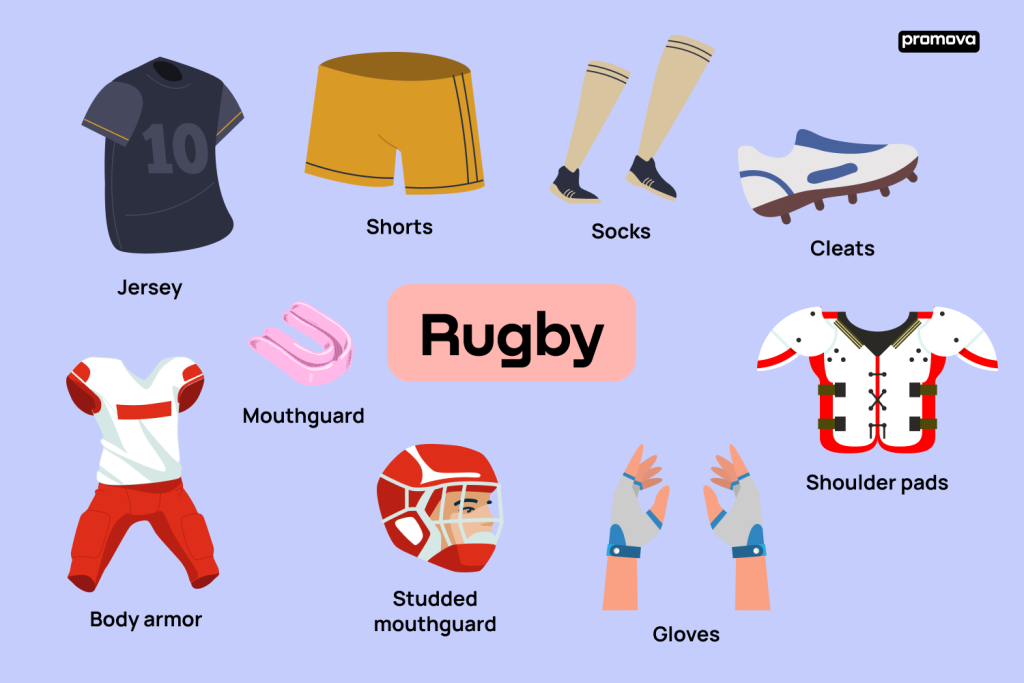Rugby is a fast-paced and physical sport. It combines strategy, skill, and teamwork.
Rugby might seem complex at first glance. But once you understand its basics, you’ll appreciate its unique charm. Originating in England, rugby has grown globally. It’s played and loved by many. The game involves two teams, an oval ball, and a goal to score points.
Players run, pass, and tackle to gain ground and score tries. It’s exciting and often thrilling to watch. Whether you’re new to rugby or looking to explain it to someone, breaking it down into simple elements can help. This guide will show you how to describe rugby clearly and easily. Dive in and discover the essence of this dynamic sport.

Credit: www.facebook.com
Introduction To Rugby
Rugby is a thrilling and dynamic sport enjoyed by millions worldwide. Known for its fast-paced action and intense physicality, rugby offers a unique blend of strategy and athleticism. Whether you’re new to the game or looking to deepen your understanding, this guide will provide a solid foundation.
Brief History
Rugby originated in England in the early 19th century. Legend has it that the game began at Rugby School when a student picked up a soccer ball and ran with it. This act of defiance laid the groundwork for the sport we know today. By the mid-1800s, rugby had formalized its rules and started to spread.
Rugby split into two codes in 1895: rugby union and rugby league. Rugby union, the more traditional form, retained amateur status for longer. Rugby league, on the other hand, introduced professionalism early on. Both forms remain popular but have different rules and styles of play.
Global Popularity
Rugby has a passionate following in many countries. It is especially popular in England, New Zealand, South Africa, and Australia. Each of these nations boasts a rich rugby heritage and competitive national teams.
The Rugby World Cup, held every four years, showcases the sport’s global appeal. This tournament draws millions of viewers and features teams from around the world. The event highlights the sport’s diverse fan base and international reach.
Rugby is also growing in regions like Asia and North America. Efforts to promote the sport in these areas have led to increased participation and interest. With its exhilarating play and inclusive spirit, rugby continues to win new fans globally.

Credit: www.instagram.com
Basic Rules
Rugby is a dynamic and thrilling sport with unique rules. Understanding the basics can make watching and playing more enjoyable. Below are some key elements of the game’s rules to get you started.
Objective Of The Game
The main aim in rugby is to score more points than the opposing team. Players achieve this by carrying, passing, kicking, and grounding the ball in the opponent’s in-goal area. The team with the most points at the end wins.
Scoring Points
There are several ways to score points in rugby:
- Try: Worth 5 points, a try is scored by grounding the ball in the opponent’s in-goal area.
- Conversion: After a try, a team can score 2 extra points by kicking the ball through the goalposts.
- Penalty Kick: Worth 3 points, a penalty kick is awarded for certain infractions by the opposing team.
- Drop Goal: Also worth 3 points, a drop goal is scored by dropping the ball and kicking it through the goalposts during open play.
Field And Equipment
Rugby, a thrilling and dynamic sport, requires a specific field and equipment. Understanding the field layout and essential gear is crucial for anyone new to the game. This section will provide clear information on both aspects.
Field Layout
The rugby field is rectangular and typically measures 100 meters long and 70 meters wide. The field has several key markings: the halfway line, 22-meter lines, and try lines. Goalposts stand at each end, forming an H-shape. Each goalpost is 5.6 meters apart, with the crossbar set at 3 meters high. The area behind the try line is known as the in-goal area, where players score tries.
Essential Gear
Players need specific gear for safety and performance. Rugby boots have studs for better grip on the field. A mouthguard protects teeth and reduces the risk of concussions. Many players wear scrum caps to safeguard their heads during tackles and scrums. Rugby shirts, shorts, and socks are made from durable materials to withstand the game’s physical nature. Additionally, players often use tape to support joints and muscles.
Players And Positions
Rugby is a dynamic sport that involves various roles on the field. Each player has a specific position and responsibility. Understanding these positions helps to appreciate the game’s structure and strategy. Let’s dive into the key roles of players in rugby.
Forwards Vs Backs
The team splits into two main groups: Forwards and Backs. Each group has unique roles and skills.
| Category | Position | Role |
|---|---|---|
| Forwards | Prop | Support in scrums and rucks |
| Forwards | Hooker | Win possession in scrums |
| Forwards | Lock | Jump in lineouts |
| Forwards | Flanker | Tackle and secure the ball |
| Forwards | Number 8 | Control the ball at the back of the scrum |
| Backs | Scrum Half | Link between forwards and backs |
| Backs | Fly Half | Make strategic decisions |
| Backs | Center | Break through defenses |
| Backs | Wing | Speed and scoring |
| Backs | Full Back | Defend against kicks |
Key Roles
The Forwards are the powerhouse of the team. They are involved in scrums, lineouts, and rucks. Their main job is to win and keep the ball. Here are some key roles:
- Prop: Strong and sturdy, these players support the hooker in scrums.
- Hooker: Positioned in the middle of the scrum, they hook the ball.
- Lock: Tall players who jump to catch the ball in lineouts.
- Flanker: Agile and fast, they tackle opponents and secure the ball.
- Number 8: Controls the ball at the back of the scrum and links with the backs.
The Backs are the speedsters and playmakers. They create and exploit space to score tries. Here are some key roles:
- Scrum Half: Quick and alert, they distribute the ball from the scrum and rucks.
- Fly Half: The decision-maker, they direct the play and kick for territory.
- Center: Strong runners who break through the opposition’s defense.
- Wing: The fastest players, they finish scoring moves with their speed.
- Full Back: The last line of defense, they catch high balls and counter-attack.
Gameplay Mechanics
Rugby is an exciting and dynamic sport with unique mechanics. Understanding these mechanics helps you appreciate the game better. Let’s delve into the critical aspects of rugby gameplay.
Kickoff And Passing
The game starts with a kickoff. The team kicking the ball aims to get it into the opponent’s half. Players must then chase the ball and try to gain possession.
Passing is essential in rugby. Players can only pass the ball backward or laterally. Forward passes are not allowed. Passing requires precise timing and skill. The ball is passed using an underhand motion, known as the spin pass, to ensure accuracy and speed.
Tackling And Rucking
Tackling is a key defensive strategy. Players must tackle opponents to stop their advance. A tackle involves wrapping arms around the opponent and bringing them to the ground. Safety is vital; tackles above the shoulders are not permitted.
After a tackle, the game moves into a phase called rucking. In a ruck, players from both teams compete for the ball on the ground. They use their feet to push the ball backward to their teammates. Maintaining possession during a ruck is crucial for controlling the game.
| Mechanic | Description |
|---|---|
| Kickoff | Initiates the game; team kicks the ball to opponent’s half. |
| Passing | Only backward or lateral passes allowed; forward passes are forbidden. |
| Tackling | Defensive action to bring opponent to the ground. |
| Rucking | Players compete for the ball after a tackle; use feet to push the ball. |
These mechanics form the backbone of rugby gameplay. Each requires skill and teamwork to execute correctly. Understanding them enhances your appreciation of the sport.
Popular Variations
Rugby is a sport with many variations. Each has its own rules and style. The two most popular types are Rugby Union and Rugby League. Let’s explore each variation in detail.
Rugby Union
Rugby Union is the older of the two variations. It is played with 15 players on each team. The game has a lot of set pieces, like scrums and lineouts. These set pieces make the game strategic. Players often kick the ball to gain territory. The game is played in two halves of 40 minutes each. The team with the most points at the end wins. Points can be scored in several ways: tries, conversions, penalty kicks, and drop goals.
Rugby League
Rugby League is faster and has fewer players. Each team has 13 players. The game focuses on continuous play. There are fewer set pieces than in Rugby Union. Players score by tries, conversions, and drop goals. There are no lineouts. Scrums are less frequent and simpler. The game has two halves of 40 minutes each. Rugby League is popular in Australia and England.
Major Competitions
Rugby has many major competitions. These events draw huge crowds. The best teams compete fiercely. Let’s explore two of these major competitions: the World Cup and the Six Nations.
World Cup
The Rugby World Cup is held every four years. It is the biggest event in rugby. Teams from all over the world compete. The tournament lasts about six weeks. The first Rugby World Cup took place in 1987. New Zealand and Australia hosted it. The winning team is awarded the Webb Ellis Cup.
During the World Cup, teams play in pool stages first. The top teams from each pool move on to the knockout stages. This includes the quarter-finals, semi-finals, and the final. The final match decides the world champion. The event is watched by millions around the globe.
Six Nations
The Six Nations Championship is an annual competition. It involves six European countries. These countries are England, France, Ireland, Italy, Scotland, and Wales. The tournament takes place over seven weeks. It usually starts in February and ends in March.
Each team plays five matches. They play each other team once. The team with the most points at the end wins the championship. Points are awarded for wins, draws, and bonus points. The winning team gets the Six Nations Trophy. If a team wins all its matches, it achieves a Grand Slam.
The Six Nations is known for its intense rivalries. Matches between England and Scotland, known as the Calcutta Cup, are particularly fierce. The competition is a highlight of the rugby calendar in Europe.
Famous Rugby Players
Rugby has given us many legendary players. Their skills and dedication have made the sport popular. This section highlights some of the most famous rugby players. They have left an indelible mark on the game.
Legends Of The Game
Several players are considered legends in rugby. Here are a few:
| Name | Country | Achievements |
|---|---|---|
| Jonah Lomu | New Zealand |
|
| Martin Johnson | England |
|
| Richie McCaw | New Zealand |
|
Current Stars
Today’s rugby stars continue to inspire new generations. Here are some current players to watch:
| Name | Country | Achievements |
|---|---|---|
| Beauden Barrett | New Zealand |
|
| Owen Farrell | England |
|
| Cheslin Kolbe | South Africa |
|
Getting Started
Rugby is an exciting and dynamic sport. It offers a blend of physical strength and strategic thinking. For beginners, understanding the basics is crucial. Getting started can seem daunting, but with the right steps, you can enjoy the game.
Joining A Club
Joining a rugby club is the first step. Most clubs welcome newcomers. They provide training sessions for beginners. Search for local clubs in your area. Visit their website or social media pages. Contact them to ask about beginner sessions. Meeting the team is a great way to learn. Clubs often have experienced players who can guide you. They help you understand the game better.
Basic Training Tips
Start with basic fitness. Rugby requires stamina and strength. Jogging, sprinting, and bodyweight exercises are helpful. Learn the basic rules of the game. Knowing the rules enhances your understanding. Practice passing the ball. Passing is a key skill in rugby. Work on your tackling technique. Safety is crucial, so learn to tackle correctly. Join training sessions regularly. Consistent practice improves your skills. Listen to your coaches and teammates. They offer valuable advice and support.

Credit: www.rugbyimports.com
Frequently Asked Questions
What Is Rugby?
Rugby is a team sport played with an oval ball. The objective is to score points by carrying or kicking the ball over the opponent’s goal line.
How Many Players Are In A Rugby Team?
A standard rugby team consists of 15 players. These include forwards and backs, each with specific roles on the field.
What Are The Basic Rules Of Rugby?
Rugby involves running with the ball, passing, and tackling. Players can only pass the ball backward. Points are scored through tries, conversions, and goals.
How Does Scoring Work In Rugby?
Scoring in rugby includes tries (5 points), conversions (2 points), penalty goals (3 points), and drop goals (3 points). Points are accumulated to determine the winner.
Conclusion
Rugby is an exciting and dynamic sport. Understanding its basics helps you appreciate the game. Players use strength and strategy to score points. The game is fast-paced and thrilling. Watching a match brings communities together. Learning rugby rules enhances the experience.
Enjoy the sport, whether you play or watch. Rugby’s spirit is about teamwork and respect. Dive into rugby and enjoy every moment.


